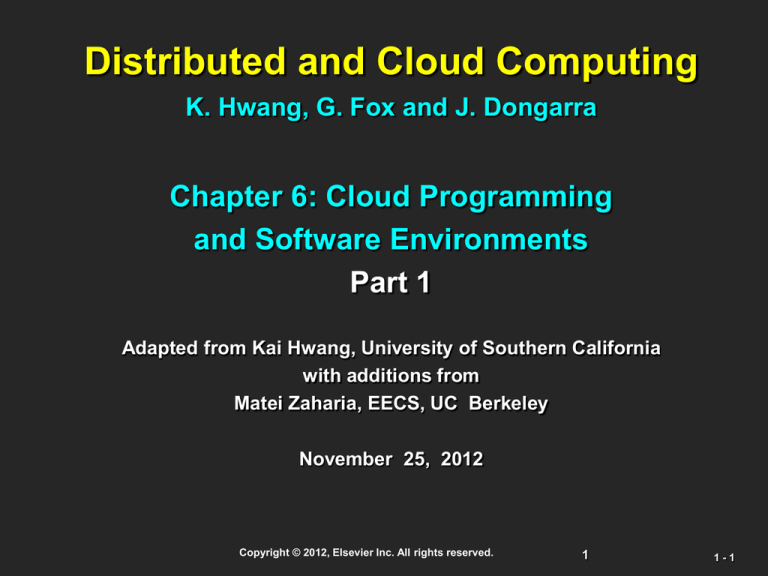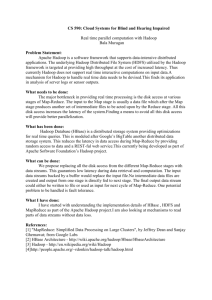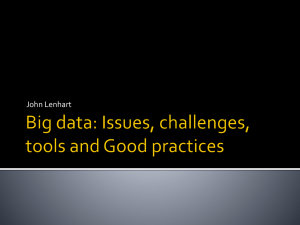
Distributed and Cloud Computing
K. Hwang, G. Fox and J. Dongarra
Chapter 6: Cloud Programming
and Software Environments
Part 1
Adapted from Kai Hwang, University of Southern California
with additions from
Matei Zaharia, EECS, UC Berkeley
November 25, 2012
Copyright © 2012, Elsevier Inc. All rights reserved.
1
1-1
Parallel Computing and Programming
Enviroments
MapReduce
Hadoop
Amazon Web Services
2
What is MapReduce?
Simple data-parallel programming model
For large-scale data processing
Pioneered by Google
Exploits large set of commodity computers
Executes process in distributed manner
Offers high availability
Processes 20 petabytes of data per day
Popularized by open-source Hadoop project
Used at Yahoo!, Facebook, Amazon, …
3
What is MapReduce used for?
At Google:
At Yahoo!:
Index construction for Google Search
Article clustering for Google News
Statistical machine translation
“Web map” powering Yahoo! Search
Spam detection for Yahoo! Mail
At Facebook:
Data mining
Ad optimization
Spam detection
4
Motivation: Large Scale Data Processing
Many tasks composed of processing lots of
data to produce lots of other data
Want to use hundreds or thousands of CPUs
... but this needs to be easy!
MapReduce provides
User-defined functions
Automatic parallelization and distribution
Fault-tolerance
I/O scheduling
Status and monitoring
5
What is MapReduce used for?
In research:
Astronomical image analysis (Washington)
Bioinformatics (Maryland)
Analyzing Wikipedia conflicts (PARC)
Natural language processing (CMU)
Particle physics (Nebraska)
Ocean climate simulation (Washington)
<Your application here>
6
Distributed Grep
matches
Split data
grep
grep
grep
Split data
grep
matches
Split data
Very
big
data
Split data
matches
matches
cat
All
matches
grep is a command-line utility for searching plain-text data sets for lines
matching a regular expression.
cat is a standard Unix utility that concatenates and lists files
7
Distributed Word Count
count
Split data
count
count
count
Split data
count
count
Split data
Very
big
data
Split data
count
count
merge
8
merged
count
Map+Reduce
M
A
P
Very
big
data
Map:
Accepts input
key/value pair
Emits intermediate
key/value pair
Partitioning
Function
R
E
D
U
C
E
Reduce :
Accepts
intermediate
key/value* pair
Emits output
key/value pair
9
Result
Architecture overview
Master node
user
Job tracker
Slave node N
Slave node 1
Slave node 2
Task tracker
Task tracker
Task tracker
Workers
Workers
Workers
10
GFS: underlying storage system
Goal
Master Node (meta server)
global view
make huge files available in the face of node failures
Centralized, index all chunks on data servers
Chunk server (data server)
File is split into contiguous chunks, typically 1664MB.
Each chunk replicated (usually 2x or 3x).
Try to keep replicas in different racks.
11
GFS architecture
GFS Master
Client
C0
C1
C5
C2
Chunkserver 1
C1
C5
C3
Chunkserver 2
…
C0
C5
C2
Chunkserver N
12
Functions in the Model
Map
Reduce
Process a key/value pair to generate intermediate
key/value pairs
Merge all intermediate values associated with the
same key
Partition
By default : hash(key) mod R
Well balanced
13
Programming Concept
Map
Perform a function on individual values in a data
set to create a new list of values
Example: square x = x * x
map square [1,2,3,4,5]
returns [1,4,9,16,25]
Reduce
Combine values in a data set to create a new
value
Example: sum = (each elem in arr, total +=)
reduce [1,2,3,4,5]
returns 15 (the sum of the elements)
14
15
Fig.6.5
Dataflow
Implementation
of MapReduce
Copyright © 2012, Elsevier Inc. All rights reserved.
16
1 - 16
A Simple Example
Counting words in a large set of documents
map(string value)
//key: document name
//value: document contents
for each word w in value
EmitIntermediate(w, “1”);
The map function emits each word w
plus an associated count of occurrences
(just a “1” is recorded in this
pseudo-code)
reduce(string key, iterator values)
//key: word
//values: list of counts
The reduce function sums together all
counts emitted for a particular word
int results = 0;
for each v in values
result += ParseInt(v);
Emit(AsString(result));
17
A Word Counting Example on <Key, Count> Distribution
Copyright © 2012, Elsevier Inc. All rights reserved.
18
1 - 18
How Does it work?
Map invocations are distributed across multiple machines by automatically
partitioning the input data into a set of M splits.
Reduce invocations are distributed by paritioning the intermediate key space into R
pieces using a hash function: hash(key) mod R.
R and the partitioning function are specified by the programmer.
19
MapReduce : Operation Steps
When the user program calls the MapReduce function, the
following sequence of actions occurs :
1)
The MapReduce library in the user program first splits the
input files into M pieces – 16 megabytes to 64 megabytes
(MB) per piece. It then starts up many copies of program on a
cluster of machines.
2) One of the copies of program is master. The rest are workers
that are assigned work by the master.
20
20
MapReduce : Operation Steps
3) A worker who is assigned a map task :
reads the contents of the corresponding input split
parses key/value pairs out of the input data and passes each
pair to the user - defined Map function.
The intermediate key/value pairs produced by the Map function
are buffered in memory.
4) The buffered pairs are written to local disk, partitioned into R
regions by the partitioning function.
The location of these buffered pairs on the local disk are
passed back to the master, who forwards these locations to the
reduce workers.
21
21
MapReduce : Operation Steps
5) When a reduce worker is notified by the master about
these locations, it reads the buffered data from the local
disks of the map workers.
When a reduce worker has read all intermediate data, it
sorts it by the intermediate keys so that all occurrences
of the same key are grouped together.
6) The reduce worker iterates over the sorted
intermediate data and for each unique intermediate key,
it passes the key and the corresponding set of
intermediate values to the user’s Reduce function.
The output of the Reduce function is appended to a
final output file.
22
22
MapReduce : Operation Steps
7) When all map tasks and reduce tasks have been
completed, the master wakes up the user program.
At this point, MapReduce call in the user program
returns back to the user code.
After successful completion, output of the mapreduce
execution is available in the R output files.
23
23
Logical Data Flow in 5 Processing
Steps in MapReduce Process
(Key, Value) Pairs are generated by the Map function over multiple available Map Workers
(VM instances). These pairs are then sorted and group based on key ordering. Different keygroups are then processed by multiple Reduce Workers in parallel.
Copyright © 2012, Elsevier Inc. All rights reserved.
24
1 - 24
Locality issue
Master scheduling policy
Asks GFS for locations of replicas of input file blocks
Map tasks typically split into 64MB (== GFS block
size)
Map tasks scheduled so GFS input block replica are
on same machine or same rack
Effect
Thousands of machines read input at local disk
speed
Without this, rack switches limit read rate
25
Fault Tolerance
Reactive way
Worker failure
Heartbeat, Workers are periodically pinged by master
NO response = failed worker
If the processor of a worker fails, the tasks of that worker
are reassigned to another worker.
Master failure
Master writes periodic checkpoints
Another master can be started from the last checkpointed
state
If eventually the master dies, the job will be aborted
26
Fault Tolerance
Proactive way (Redundant Execution)
The problem of “stragglers” (slow workers)
Other jobs consuming resources on machine
Bad disks with soft errors transfer data very slowly
Weird things: processor caches disabled (!!)
When computation almost done, reschedule inprogress tasks
Whenever either the primary or the backup
executions finishes, mark it as completed
27
Fault Tolerance
Input error: bad records
Map/Reduce functions sometimes fail for particular
inputs
Best solution is to debug & fix, but not always
possible
On segment fault
Send UDP packet to master from signal handler
Include sequence number of record being processed
Skip bad records
If master sees two failures for same record, next worker is
told to skip the record
28
Status monitor
29
Points need to be emphasized
No reduce can begin until map is complete
Master must communicate locations of
intermediate files
Tasks scheduled based on location of data
If map worker fails any time before reduce
finishes, task must be completely rerun
MapReduce library does most of the hard work
for us!
30
Other Examples
Distributed Grep:
Map function emits a line if it matches a supplied pattern.
Reduce function is an identity function that copies the supplied
intermediate data to the output.
Count of URL accesses:
Map function processes logs of web page requests and outputs <URL, 1>,
Reduce function adds together all values for the same URL, emitting <URL,
total count> pairs.
Reverse Web-Link graph; e.g., all URLs with reference to http://dblab.usc.edu:
Map function outputs <tgt, src> for each link to a tgt in a page named src,
Reduce concatenates the list of all src URLS associated with a given tgt
URL and emits the pair: <tgt, list(src)>.
Inverted Index; e.g., all URLs with 585 as a word:
Map function parses each document, emitting a sequence of <word,
doc_ID>,
Reduce accepts all pairs for a given word, sorts the corresponding doc_IDs
and emits a <word, list(doc_ID)> pair.
Set of all output pairs forms a simple inverted index.
31
MapReduce Implementations
MapReduce
Cluster,
1, Google
2, Apache Hadoop
Multicore CPU,
Phoenix @ stanford
GPU,
Mars@HKUST
32
Hadoop : software platform originally developed by Yahoo
enabling users to write and run applications over vast
distributed data.
Attractive Features in Hadoop :
Scalable : can easily scale to store and process petabytes of
data in the Web space
Economical : An open-source MapReduce minimizes the
overheads in task spawning and massive data communication.
Efficient: Processing data with high-degree of parallelism
across a large number of commodity nodes
Reliable : Automatically maintains multiple copies of data to
facilitate redeployment of computing tasks on failures
Copyright © 2012, Elsevier Inc. All rights reserved.
33
1 - 33
Typical Hadoop Cluster
Aggregation switch
Rack switch
40 nodes/rack, 1000-4000 nodes in cluster
1 Gbps bandwidth within rack, 8 Gbps out of rack
Node specs (Yahoo terasort):
8 x 2GHz cores, 8 GB RAM, 4 disks (= 4 TB?)
34
Image from http://wiki.apache.org/hadoop-data/attachments/HadoopPresentations/attachments/YahooHadoopIntro-apachecon-us-2008.pdf
Typical Hadoop Cluster
35
Image from http://wiki.apache.org/hadoop-data/attachments/HadoopPresentations/attachments/aw-apachecon-eu-2009.pdf
Challenges
Cheap nodes fail, especially if you have many
1.
2.
3.
Mean time between failures for 1 node = 3 years
Mean time between failures for 1000 nodes = 1 day
Solution: Build fault-tolerance into system
Commodity network = low bandwidth
1.
Solution: Push computation to the data
Programming distributed systems is hard
1.
Solution: Data-parallel programming model: users
write “map” & “reduce” functions, system distributes
work and handles faults
36
Hadoop Components
Distributed file system (HDFS)
Single namespace for entire cluster
Replicates data 3x for fault-tolerance
MapReduce framework
Executes user jobs specified as “map” and
“reduce” functions
Manages work distribution & fault-tolerance
37
Hadoop Distributed File System
Files split into 128MB
blocks
Blocks replicated across
several datanodes (usually
3)
Single namenode stores
metadata (file names, block
locations, etc)
Optimized for large files,
sequential reads
Files are append-only
Namenode
File1
1
2
3
4
1
2
4
2
1
3
1
4
3
Datanodes
38
3
2
4
Copyright © 2012, Elsevier Inc. All rights reserved.
39
1 - 39
Secure Query Processing with
Hadoop/MapReduce
Query Rewriting and Optimization Principles defined and
implemented for two types of data
(i) Relational data: Secure query processing with HIVE
(ii) RDF Data: Secure query processing with SPARQL
Demonstrated with XACML Policies (content, temporal,
association)
Joint demonstration with Kings College and U. of Insubria
First demo (2010): Each party submits their data and policies
Our cloud will manage the data and policies
Second demo (2011): Multiple clouds
Copyright © 2012, Elsevier Inc. All rights reserved.
40
1 - 40
Higher-level languages over
Hadoop: Pig and Hive
41
Motivation
Many parallel algorithms can be expressed by
a series of MapReduce jobs
But MapReduce is fairly low-level: must think
about keys, values, partitioning, etc
Can we capture common “job building blocks”?
42
Pig
Started at Yahoo! Research
Runs about 30% of Yahoo!’s jobs
Features:
Expresses sequences of MapReduce jobs
Data model: nested “bags” of items
Provides relational (SQL) operators (JOIN, GROUP
BY, etc)
Easy to plug in Java functions
Pig Pen development environment for Eclipse
43
An Example Problem
Suppose you have
user data in one file,
page view data in
another, and you need
to find the top 5 most
visited pages by users
aged 18 - 25.
Load Users
Load Pages
Filter by age
Join on name
Group on url
Count clicks
Order by clicks
Take top 5
44
Example from http://wiki.apache.org/pig-data/attachments/PigTalksPapers/attachments/ApacheConEurope09.ppt
In MapReduce
import
import
import
import
java.io.IOException;
java.util.ArrayList;
java.util.Iterator;
java.util.List;
reporter.setStatus("OK");
lp.setOutputKeyClass(Text.class);
lp.setOutputValueClass(Text.class);
lp.setMapperClass(LoadPages.class);
// Do the cross product and collect the values
FileInputFormat.addInputPath(lp, new
for (String s1 : first) {
Path("/
user/gates/pages"));
import org.apache.hadoop.fs.Path;
for (String s2 : second) {
FileOutputFormat.setOutputPath(lp,
import org.apache.hadoop.io.LongWritable;
String outval = key + "," + s1 + "," + s2;
new Path("/user/gates/tmp/indexed_pages
import org.apache.hadoop.io.Text;
oc.collect(null, new Text(outval));
lp.setNumReduceTasks(0);
import org.apache.hadoop.io.Writable;
reporter.setStatus("OK");
Job loadPages = new Job(lp);
import org.apache.hadoop.io.WritableComparable;
}
import org.apache.hadoop.mapred.FileInputFormat;
}
JobConf lfu = new JobConf(MRExample.class);
import org.apache.hadoop.mapred.FileOutputFormat;
}
lfu.s
etJobName("Load and Filter Users");
import org.apache.hadoop.mapred.JobConf;
}
lfu.setInputFormat(TextInputFormat.class);
import org.apache.hadoop.mapred.KeyValueTextInputFormat;
public static class LoadJoined extends MapReduceBase
lfu.setOutputKeyClass(Text.class);
import org.a
pache.hadoop.mapred.Mapper;
implements Mapper<Text, Text, Text, LongWritable> {
lfu.setOutputValueClass(Text.class);
import org.apache.hadoop.mapred.MapReduceBase;
lfu.setMapperClass(LoadAndFilterUsers.class
import org.apache.hadoop.mapred.OutputCollector;
public void map(
FileInputFormat.add
InputPath(lfu, new
import org.apache.hadoop.mapred.RecordReader;
Text k,
Path("/user/gates/users"));
import org.apache.hadoop.mapred.Reducer;
Text val,
FileOutputFormat.setOutputPath(lfu,
import org.apache.hadoop.mapred.Reporter;
OutputColle
ctor<Text, LongWritable> oc,
new Path("/user/gates/tmp/filtered_user
imp
o rt org.apache.hadoop.mapred.SequenceFileInputFormat;
Reporter reporter) throws IOException {
lfu.setNumReduceTasks(0);
import org.apache.hadoop.mapred.SequenceFileOutputFormat;
// Find the url
Job loadUsers = new Job(lfu);
import org.apache.hadoop.mapred.TextInputFormat;
String line = val.toString();
import org.apache.hadoop.mapred.jobcontrol.Job;
int firstComma = line.indexOf(',');
JobConf join = new
MRExample.class);
JobConf(
import org.apache.hadoop.mapred.jobcontrol.JobC
ontrol;
int secondComma = line.indexOf(',',
Comma);
first
join.setJobName("Join Users and Pages");
import org.apache.hadoop.mapred.lib.IdentityMapper;
String key = line.substring(firstComma, secondComma);
join.setInputFormat(KeyValueTextInputFormat
// drop the rest of the record, I don't need it anymore,
join.setOutputKeyClass(Text.class);
public class MRExample {
// just pass a 1 for the combiner/reducer to sum instead.
join.setOutputValueClass(Text.class);
public static class LoadPages extends MapReduceBase
Text outKey = new Text(key);
join.setMapperClass(IdentityMap
per.class);
implements Mapper<LongWritable, Text, Text, Text> {
oc.collect(outKey, new LongWritable(1L));
join.setReducerClass(Join.class);
}
FileInputFormat.addInputPath(join, new
public void map(LongWritable k, Text val,
}
Path("/user/gates/tmp/indexed_pages"));
OutputCollector<Text, Text> oc,
public static class ReduceUrls extends MapReduceBase
FileInputFormat.addInputPath(join, new
Reporter reporter) throws IOException {
implements Reducer<Text, LongWritable, WritableComparable,
Path("/user/gates/tmp/filtered_users"));
// Pull the key out
Writable> {
FileOutputFormat.se
tOutputPath(join, new
String line = val.toString();
Path("/user/gates/tmp/joined"));
int firstComma = line.indexOf(',');
public void reduce(
join.setNumReduceTasks(50);
String key string(0,
= line.subfirstComma);
y,
Text ke
Job joinJob = new Job(join);
String value = line.substring(firstComma + 1);
Iterator<LongWritable> iter,
joinJob.addDependingJob(loadPages);
Text outKey = new Text(key);
OutputCollector<WritableComparable, Writable> joinJob.addDependingJob(loadUsers);
oc,
// Prepend an index to the value so we know which file
Reporter reporter) throws IOException {
// it came from.
// Add up all the values we see
JobConf group = newxample.class);
JobConf(MRE
Text outVal = "
new
+ value);
Text("1
group.setJobName("Group URLs");
oc.collect(outKey, outVal);
long sum = 0;
group.setInputFormat(KeyValueTextInputForma
}
ile
wh(iter.hasNext()) {
group.setOutputKeyClass(Text.class);
}
sum += iter.next().get();
group.setOutputValueClass(LongWritable.clas
public static class LoadAndFilterUsers extends MapReduceBase
reporter.setStatus("OK");
group.setOutputFormat(SequenceFi
leOutputFormat.class);
implements Mapper<LongWritable, Text, Text, Text> {
}
group.setMapperClass(LoadJoined.class);
group.setCombinerClass(ReduceUrls.class);
public void map(LongWritable k, Text val,
oc.collect(key, new LongWritable(sum));
group.setReducerClass(ReduceUrls.class);
OutputCollector<Text, Text> oc,
}
FileInputFormat.addInputPath(group, new
Reporter reporter) throws IOException {
}
Path("/user/gates/tmp/joined"));
// Pull the key out
public static class LoadClicks extends MapReduceBase
FileOutputFormat.setOutputPath(group, new
String line = val.toString();
mplements
i
Mapper<WritableComparable, Writable, LongWritable,
Path("/user/gates/tmp/grouped"));
int firstComma = line.indexOf(',');
Text> {
group.setNumReduceTasks(50);
String value = line.substring(
firstComma + 1);
Job groupJob = new Job(group);
int age = Integer.parseInt(value);
public void map(
groupJob.addDependingJob(joinJob);
if (age < 18 || age > 25) return;
WritableComparable key,
String key = line.substring(0, firstComma);
Writable val,
JobConf top100 = new JobConf(MRExample.clas
Text outKey = new Text(key);
OutputCollector<LongWritable, Text> oc,
top100.setJobName("Top 100 sites");
// Prepend an index toe the
know
value
which
sofile
w
Reporter throws
reporter)
IOException {
top100.setInputFormat(SequenceFileInputForm
// it came from.
oc.collect((LongWritable)val, (Text)key);
top100.setOutputKeyClass(LongWritable.class
Text outVal = new Text("2" + value);
}
top100.setOutputValueClass(Text.class);
oc.collect(outKey, outVal);
}
top100.setOutputFormat(SequenceFileOutputF
ormat.class);
}
public static class LimitClicks extends MapReduceBase
top100.setMapperClass(LoadClicks.class);
}
implements Reducer<LongWritable, Text, LongWritable, Text>
top100.setCombinerClass(LimitClicks.class);
{
public static class Join extends MapReduceBase
top100.setReducerClass(LimitClicks.class);
implements Reducer<Text, Text, Text, Text> {
int count = 0;
FileInputFormat.addInputPath(top100, new
public
void reduce(
Path("/user/gates/tmp/grouped"));
public void reduce(Text key,
LongWritable key,
FileOutputFormat.setOutputPath(top100, new
Iterator<Text> iter,
Iterator<Text> iter,
Path("/user/gates/top100sitesforusers18to25"));
OutputCollector<Text, Text> oc,
OutputCollector<LongWritable, Text> oc,
top100.setNumReduceTasks(1);
Reporter reporter) throws IOException {
Reporter reporter) throws IOException {
Job limit = new Job(top100);
// For each value, figure out which file it's from and
limit.addDependingJob(groupJob);
store it
// Only output the first 100 records
// accordingly.
while <(count
100 && iter.hasNext()) {
JobControl jc = new JobControl("Find
100 sites for
top use
List<String> first = new ArrayList<String>();
oc.collect(key, iter.next());
18 to 25");
List<String> second = new ArrayList<String>();
count++;
jc.addJob(loadPages);
}
jc.addJob(loadUsers);
while (iter.hasNext()) {
}
jc.addJob(joinJob);
Text t = iter.next();
}
jc.addJob(groupJob);
String value
String();
= t.to
public static void main(String[] args) throws IOException jc.addJob(limit);
{
if (value.charAt(0) == '1')
JobConf lp = new JobConf(MRExample.class);
jc.run();
first.add(value.substring(1));
lp.se
tJobName("Load Pages");
}
else second.add(value.substring(1));
lp.setInputFormat(TextInputFormat.class);
}
}
45
Example from http://wiki.apache.org/pig-data/attachments/PigTalksPapers/attachments/ApacheConEurope09.ppt
In Pig Latin
Users
= load ‘users’ as (name, age);
Filtered = filter Users by
age >= 18 and age <= 25;
Pages
= load ‘pages’ as (user, url);
Joined
= join Filtered by name, Pages by user;
Grouped = group Joined by url;
Summed
= foreach Grouped generate group,
count(Joined) as clicks;
Sorted
= order Summed by clicks desc;
Top5
= limit Sorted 5;
store Top5 into ‘top5sites’;
46
Example from http://wiki.apache.org/pig-data/attachments/PigTalksPapers/attachments/ApacheConEurope09.ppt
Ease of Translation
Notice how naturally the components of the job translate into Pig Latin.
Load Users
Load Pages
Filter by age
Join on name
Group on url
Count clicks
Order by clicks
Users = load …
Filtered = filter …
Pages = load …
Joined = join …
Grouped = group …
Summed = … count()…
Sorted = order …
Top5 = limit …
Take top 5
47
Example from http://wiki.apache.org/pig-data/attachments/PigTalksPapers/attachments/ApacheConEurope09.ppt
Ease of Translation
Notice how naturally the components of the job translate into Pig Latin.
Load Users
Load Pages
Filter by age
Join on name
Job 1
Group on url
Job 2
Count clicks
Order by clicks
Users = load …
Filtered = filter …
Pages = load …
Joined = join …
Grouped = group …
Summed = … count()…
Sorted = order …
Top5 = limit …
Job 3
Take top 5
Example from http://wiki.apache.org/pig-data/attachments/PigTalksPapers/attachments/ApacheConEurope09.ppt
48
Hive
Developed at Facebook
Used for majority of Facebook jobs
“Relational database” built on Hadoop
Maintains list of table schemas
SQL-like query language (HQL)
Can call Hadoop Streaming scripts from HQL
Supports table partitioning, clustering, complex
data types, some optimizations
49
Sample Hive Queries
• Find top 5 pages visited by users aged 18-25:
SELECT p.url, COUNT(1) as clicks
FROM users u JOIN page_views p ON (u.name = p.user)
WHERE u.age >= 18 AND u.age <= 25
GROUP BY p.url
ORDER BY clicks
LIMIT 5;
• Filter page views through Python script:
SELECT TRANSFORM(p.user, p.date)
USING 'map_script.py'
AS dt, uid CLUSTER BY dt
FROM page_views p;
50
Amazon Elastic MapReduce
Provides a web-based interface and commandline tools for running Hadoop jobs on Amazon
EC2
Data stored in Amazon S3
Monitors job and shuts down machines after
use
Small extra charge on top of EC2 pricing
If you want more control over how you Hadoop
runs, you can launch a Hadoop cluster on EC2
manually using the scripts in src/contrib/ec2
51
Elastic MapReduce Workflow
52
Elastic MapReduce Workflow
53
Elastic MapReduce Workflow
54
Elastic MapReduce Workflow
55
Conclusions
MapReduce programming model hides the complexity of
work distribution and fault tolerance
Principal design philosophies:
Make it scalable, so you can throw hardware at problems
Make it cheap, lowering hardware, programming and admin
costs
MapReduce is not suitable for all problems, but when it
works, it may save you quite a bit of time
Cloud computing makes it straightforward to start using
Hadoop (or other parallel software) at scale
56
Resources
Hadoop: http://hadoop.apache.org/core/
Pig: http://hadoop.apache.org/pig
Hive: http://hadoop.apache.org/hive
Video tutorials: http://www.cloudera.com/hadoop-training
Amazon Web Services: http://aws.amazon.com/
Amazon Elastic MapReduce guide:
http://docs.amazonwebservices.com/ElasticMapReduce/lat
est/GettingStartedGuide/
57







